University Psychology Essay: Theories and Treatment of Depression
VerifiedAdded on 2023/06/09
|9
|2216
|124
Essay
AI Summary
This psychology essay delves into the complexities of depression, also known as major depressive disorder, and explores three prominent theories for its treatment: reinforcement theory, self-control theory, and cognitive theory. The essay begins by defining depression and highlighting its impact on individuals' daily lives, including the potential for suicidal ideations. It then examines B.F. Skinner's reinforcement theory, explaining how insufficient reinforcement can contribute to depression and how techniques like positive reinforcement and time projection can be used in therapy. The self-control theory, based on the work of Lynn P. Rehm, is also discussed, focusing on self-monitoring, self-evaluation, and self-reinforcement deficits in depressed individuals, and outlining a six-week therapy approach. Finally, the essay explores Aaron Beck's cognitive theory, which posits that depression arises from irrational cognitions and maladaptive thought patterns. The essay describes the cognitive triad, negative self-schemas, and logical errors associated with depression, and how cognitive techniques can be used to modify these thought processes. The essay concludes by emphasizing the effectiveness of these theories in reducing depressive symptoms, offering a comprehensive overview of different approaches to understanding and treating depression. This document is contributed by a student to be published on the website Desklib.
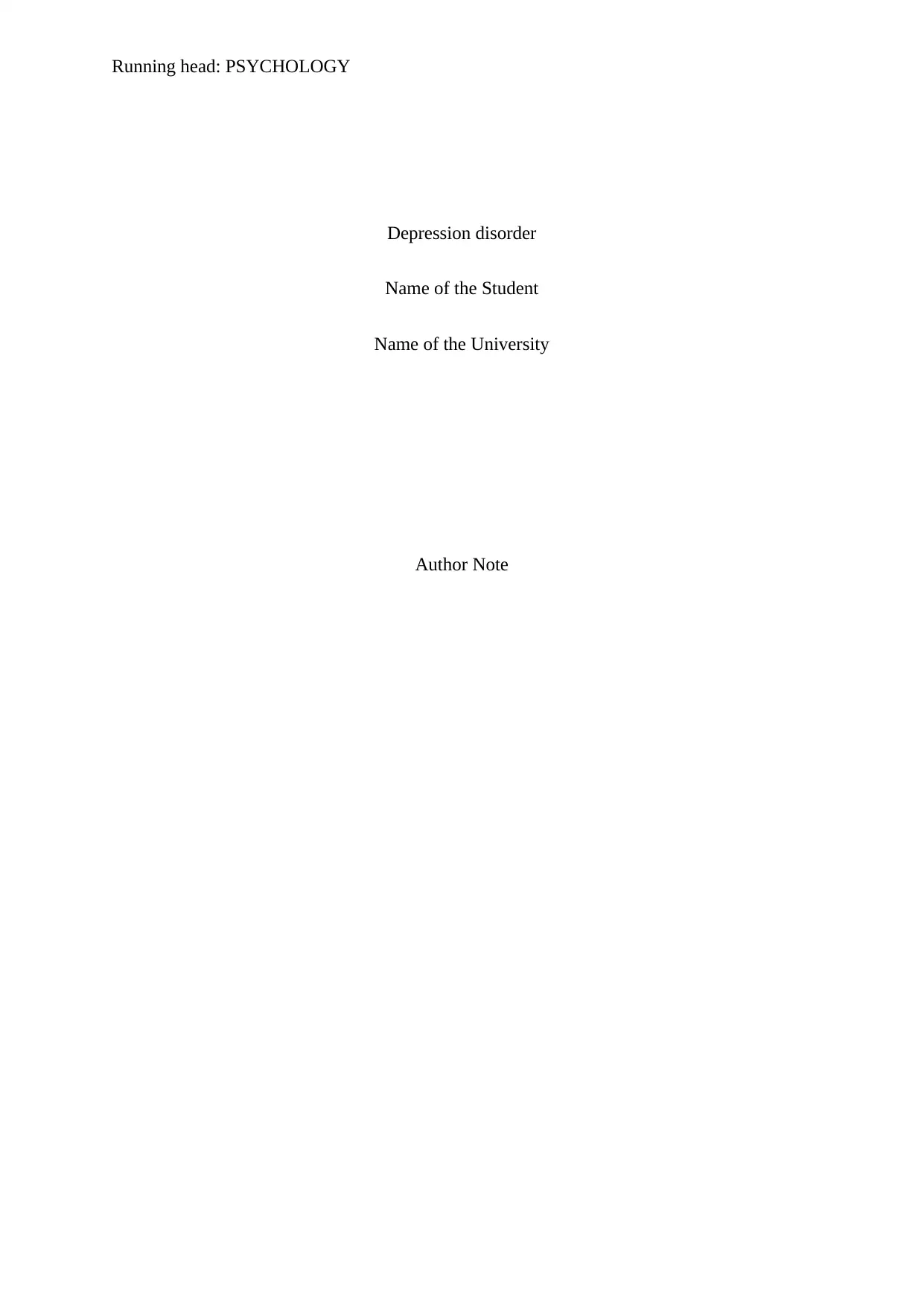
Running head: PSYCHOLOGY
Depression disorder
Name of the Student
Name of the University
Author Note
Depression disorder
Name of the Student
Name of the University
Author Note
Paraphrase This Document
Need a fresh take? Get an instant paraphrase of this document with our AI Paraphraser
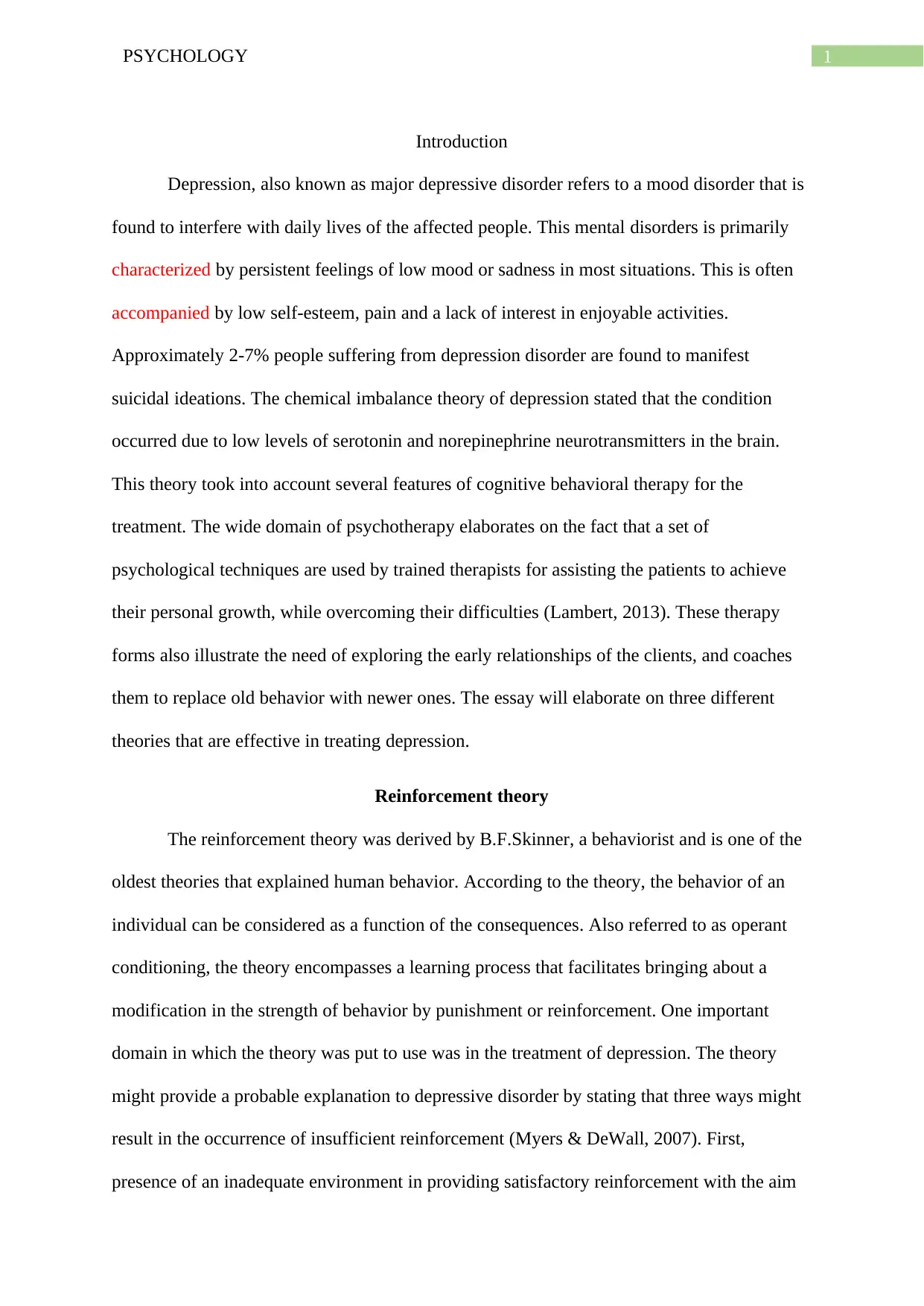
1PSYCHOLOGY
Introduction
Depression, also known as major depressive disorder refers to a mood disorder that is
found to interfere with daily lives of the affected people. This mental disorders is primarily
characterized by persistent feelings of low mood or sadness in most situations. This is often
accompanied by low self-esteem, pain and a lack of interest in enjoyable activities.
Approximately 2-7% people suffering from depression disorder are found to manifest
suicidal ideations. The chemical imbalance theory of depression stated that the condition
occurred due to low levels of serotonin and norepinephrine neurotransmitters in the brain.
This theory took into account several features of cognitive behavioral therapy for the
treatment. The wide domain of psychotherapy elaborates on the fact that a set of
psychological techniques are used by trained therapists for assisting the patients to achieve
their personal growth, while overcoming their difficulties (Lambert, 2013). These therapy
forms also illustrate the need of exploring the early relationships of the clients, and coaches
them to replace old behavior with newer ones. The essay will elaborate on three different
theories that are effective in treating depression.
Reinforcement theory
The reinforcement theory was derived by B.F.Skinner, a behaviorist and is one of the
oldest theories that explained human behavior. According to the theory, the behavior of an
individual can be considered as a function of the consequences. Also referred to as operant
conditioning, the theory encompasses a learning process that facilitates bringing about a
modification in the strength of behavior by punishment or reinforcement. One important
domain in which the theory was put to use was in the treatment of depression. The theory
might provide a probable explanation to depressive disorder by stating that three ways might
result in the occurrence of insufficient reinforcement (Myers & DeWall, 2007). First,
presence of an inadequate environment in providing satisfactory reinforcement with the aim
Introduction
Depression, also known as major depressive disorder refers to a mood disorder that is
found to interfere with daily lives of the affected people. This mental disorders is primarily
characterized by persistent feelings of low mood or sadness in most situations. This is often
accompanied by low self-esteem, pain and a lack of interest in enjoyable activities.
Approximately 2-7% people suffering from depression disorder are found to manifest
suicidal ideations. The chemical imbalance theory of depression stated that the condition
occurred due to low levels of serotonin and norepinephrine neurotransmitters in the brain.
This theory took into account several features of cognitive behavioral therapy for the
treatment. The wide domain of psychotherapy elaborates on the fact that a set of
psychological techniques are used by trained therapists for assisting the patients to achieve
their personal growth, while overcoming their difficulties (Lambert, 2013). These therapy
forms also illustrate the need of exploring the early relationships of the clients, and coaches
them to replace old behavior with newer ones. The essay will elaborate on three different
theories that are effective in treating depression.
Reinforcement theory
The reinforcement theory was derived by B.F.Skinner, a behaviorist and is one of the
oldest theories that explained human behavior. According to the theory, the behavior of an
individual can be considered as a function of the consequences. Also referred to as operant
conditioning, the theory encompasses a learning process that facilitates bringing about a
modification in the strength of behavior by punishment or reinforcement. One important
domain in which the theory was put to use was in the treatment of depression. The theory
might provide a probable explanation to depressive disorder by stating that three ways might
result in the occurrence of insufficient reinforcement (Myers & DeWall, 2007). First,
presence of an inadequate environment in providing satisfactory reinforcement with the aim
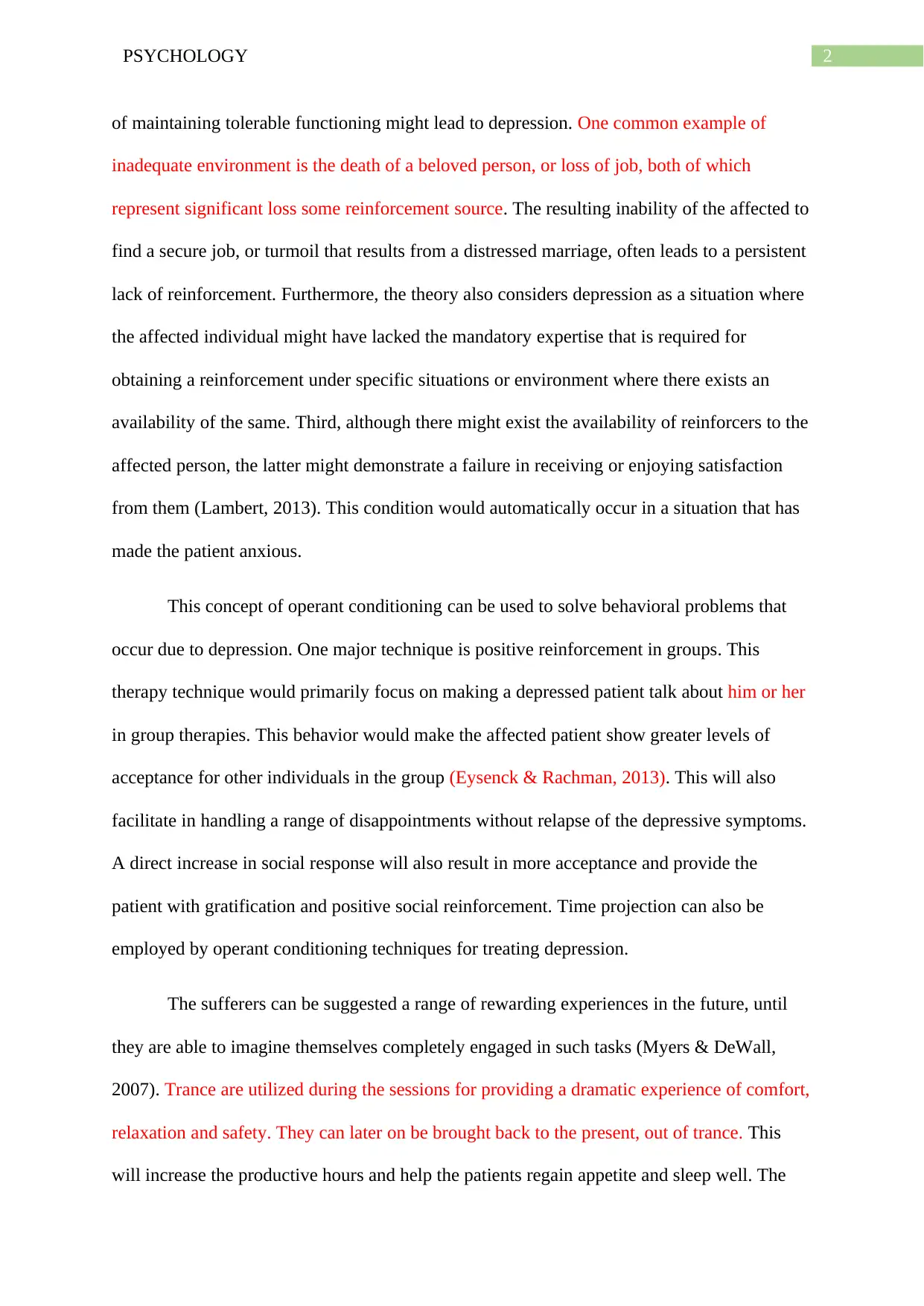
2PSYCHOLOGY
of maintaining tolerable functioning might lead to depression. One common example of
inadequate environment is the death of a beloved person, or loss of job, both of which
represent significant loss some reinforcement source. The resulting inability of the affected to
find a secure job, or turmoil that results from a distressed marriage, often leads to a persistent
lack of reinforcement. Furthermore, the theory also considers depression as a situation where
the affected individual might have lacked the mandatory expertise that is required for
obtaining a reinforcement under specific situations or environment where there exists an
availability of the same. Third, although there might exist the availability of reinforcers to the
affected person, the latter might demonstrate a failure in receiving or enjoying satisfaction
from them (Lambert, 2013). This condition would automatically occur in a situation that has
made the patient anxious.
This concept of operant conditioning can be used to solve behavioral problems that
occur due to depression. One major technique is positive reinforcement in groups. This
therapy technique would primarily focus on making a depressed patient talk about him or her
in group therapies. This behavior would make the affected patient show greater levels of
acceptance for other individuals in the group (Eysenck & Rachman, 2013). This will also
facilitate in handling a range of disappointments without relapse of the depressive symptoms.
A direct increase in social response will also result in more acceptance and provide the
patient with gratification and positive social reinforcement. Time projection can also be
employed by operant conditioning techniques for treating depression.
The sufferers can be suggested a range of rewarding experiences in the future, until
they are able to imagine themselves completely engaged in such tasks (Myers & DeWall,
2007). Trance are utilized during the sessions for providing a dramatic experience of comfort,
relaxation and safety. They can later on be brought back to the present, out of trance. This
will increase the productive hours and help the patients regain appetite and sleep well. The
of maintaining tolerable functioning might lead to depression. One common example of
inadequate environment is the death of a beloved person, or loss of job, both of which
represent significant loss some reinforcement source. The resulting inability of the affected to
find a secure job, or turmoil that results from a distressed marriage, often leads to a persistent
lack of reinforcement. Furthermore, the theory also considers depression as a situation where
the affected individual might have lacked the mandatory expertise that is required for
obtaining a reinforcement under specific situations or environment where there exists an
availability of the same. Third, although there might exist the availability of reinforcers to the
affected person, the latter might demonstrate a failure in receiving or enjoying satisfaction
from them (Lambert, 2013). This condition would automatically occur in a situation that has
made the patient anxious.
This concept of operant conditioning can be used to solve behavioral problems that
occur due to depression. One major technique is positive reinforcement in groups. This
therapy technique would primarily focus on making a depressed patient talk about him or her
in group therapies. This behavior would make the affected patient show greater levels of
acceptance for other individuals in the group (Eysenck & Rachman, 2013). This will also
facilitate in handling a range of disappointments without relapse of the depressive symptoms.
A direct increase in social response will also result in more acceptance and provide the
patient with gratification and positive social reinforcement. Time projection can also be
employed by operant conditioning techniques for treating depression.
The sufferers can be suggested a range of rewarding experiences in the future, until
they are able to imagine themselves completely engaged in such tasks (Myers & DeWall,
2007). Trance are utilized during the sessions for providing a dramatic experience of comfort,
relaxation and safety. They can later on be brought back to the present, out of trance. This
will increase the productive hours and help the patients regain appetite and sleep well. The
⊘ This is a preview!⊘
Do you want full access?
Subscribe today to unlock all pages.

Trusted by 1+ million students worldwide
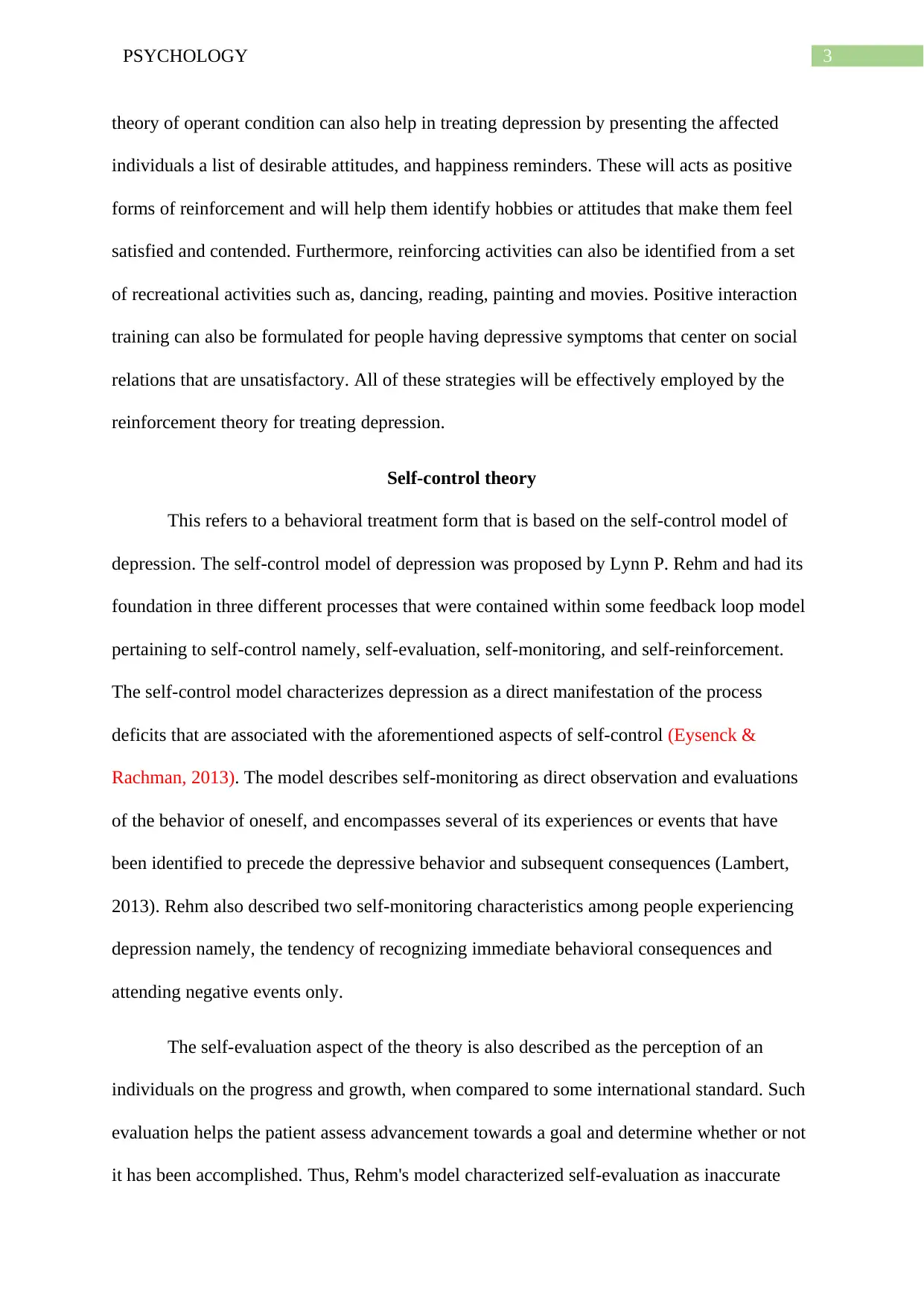
3PSYCHOLOGY
theory of operant condition can also help in treating depression by presenting the affected
individuals a list of desirable attitudes, and happiness reminders. These will acts as positive
forms of reinforcement and will help them identify hobbies or attitudes that make them feel
satisfied and contended. Furthermore, reinforcing activities can also be identified from a set
of recreational activities such as, dancing, reading, painting and movies. Positive interaction
training can also be formulated for people having depressive symptoms that center on social
relations that are unsatisfactory. All of these strategies will be effectively employed by the
reinforcement theory for treating depression.
Self-control theory
This refers to a behavioral treatment form that is based on the self-control model of
depression. The self-control model of depression was proposed by Lynn P. Rehm and had its
foundation in three different processes that were contained within some feedback loop model
pertaining to self-control namely, self-evaluation, self-monitoring, and self-reinforcement.
The self-control model characterizes depression as a direct manifestation of the process
deficits that are associated with the aforementioned aspects of self-control (Eysenck &
Rachman, 2013). The model describes self-monitoring as direct observation and evaluations
of the behavior of oneself, and encompasses several of its experiences or events that have
been identified to precede the depressive behavior and subsequent consequences (Lambert,
2013). Rehm also described two self-monitoring characteristics among people experiencing
depression namely, the tendency of recognizing immediate behavioral consequences and
attending negative events only.
The self-evaluation aspect of the theory is also described as the perception of an
individuals on the progress and growth, when compared to some international standard. Such
evaluation helps the patient assess advancement towards a goal and determine whether or not
it has been accomplished. Thus, Rehm's model characterized self-evaluation as inaccurate
theory of operant condition can also help in treating depression by presenting the affected
individuals a list of desirable attitudes, and happiness reminders. These will acts as positive
forms of reinforcement and will help them identify hobbies or attitudes that make them feel
satisfied and contended. Furthermore, reinforcing activities can also be identified from a set
of recreational activities such as, dancing, reading, painting and movies. Positive interaction
training can also be formulated for people having depressive symptoms that center on social
relations that are unsatisfactory. All of these strategies will be effectively employed by the
reinforcement theory for treating depression.
Self-control theory
This refers to a behavioral treatment form that is based on the self-control model of
depression. The self-control model of depression was proposed by Lynn P. Rehm and had its
foundation in three different processes that were contained within some feedback loop model
pertaining to self-control namely, self-evaluation, self-monitoring, and self-reinforcement.
The self-control model characterizes depression as a direct manifestation of the process
deficits that are associated with the aforementioned aspects of self-control (Eysenck &
Rachman, 2013). The model describes self-monitoring as direct observation and evaluations
of the behavior of oneself, and encompasses several of its experiences or events that have
been identified to precede the depressive behavior and subsequent consequences (Lambert,
2013). Rehm also described two self-monitoring characteristics among people experiencing
depression namely, the tendency of recognizing immediate behavioral consequences and
attending negative events only.
The self-evaluation aspect of the theory is also described as the perception of an
individuals on the progress and growth, when compared to some international standard. Such
evaluation helps the patient assess advancement towards a goal and determine whether or not
it has been accomplished. Thus, Rehm's model characterized self-evaluation as inaccurate
Paraphrase This Document
Need a fresh take? Get an instant paraphrase of this document with our AI Paraphraser
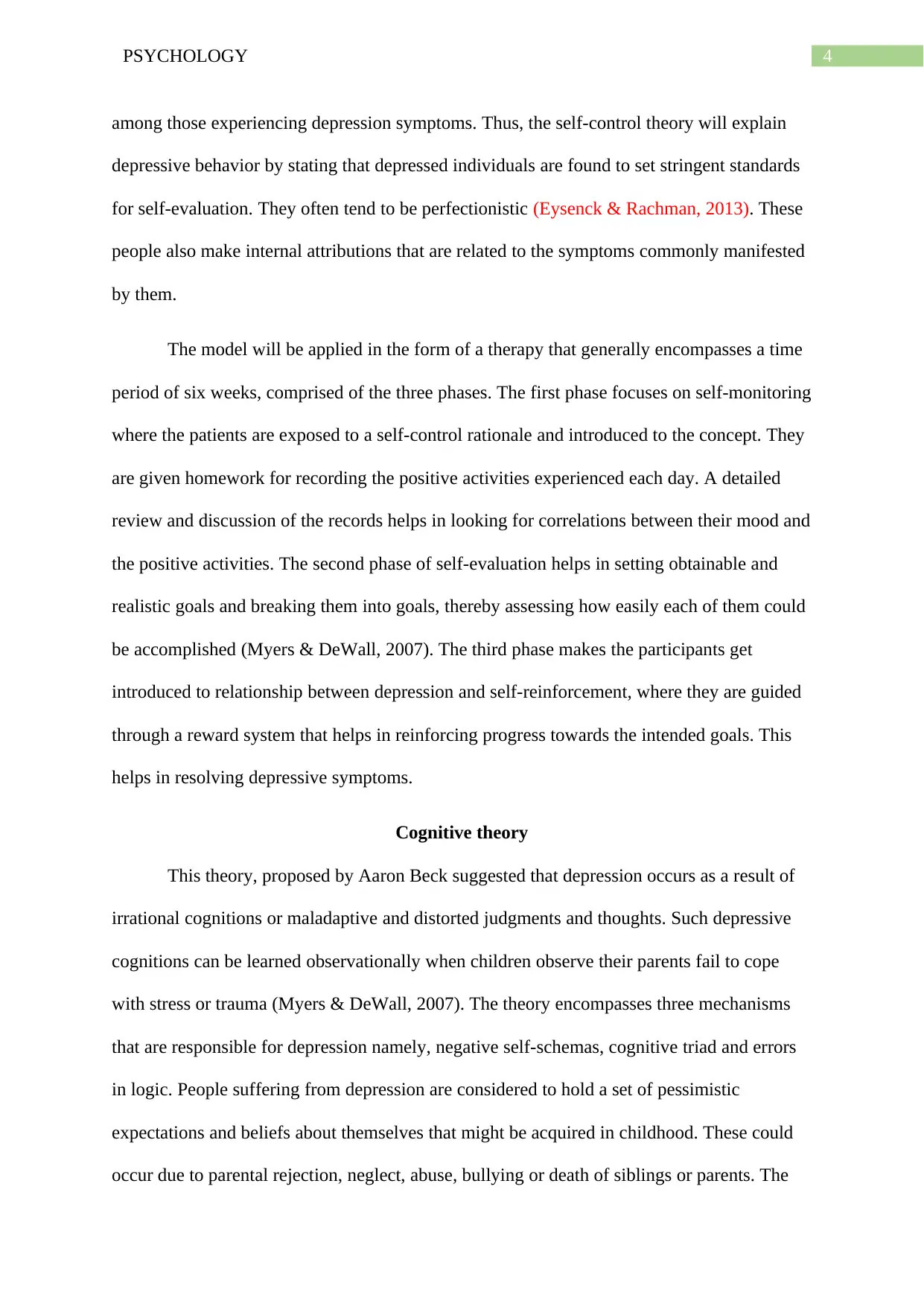
4PSYCHOLOGY
among those experiencing depression symptoms. Thus, the self-control theory will explain
depressive behavior by stating that depressed individuals are found to set stringent standards
for self-evaluation. They often tend to be perfectionistic (Eysenck & Rachman, 2013). These
people also make internal attributions that are related to the symptoms commonly manifested
by them.
The model will be applied in the form of a therapy that generally encompasses a time
period of six weeks, comprised of the three phases. The first phase focuses on self-monitoring
where the patients are exposed to a self-control rationale and introduced to the concept. They
are given homework for recording the positive activities experienced each day. A detailed
review and discussion of the records helps in looking for correlations between their mood and
the positive activities. The second phase of self-evaluation helps in setting obtainable and
realistic goals and breaking them into goals, thereby assessing how easily each of them could
be accomplished (Myers & DeWall, 2007). The third phase makes the participants get
introduced to relationship between depression and self-reinforcement, where they are guided
through a reward system that helps in reinforcing progress towards the intended goals. This
helps in resolving depressive symptoms.
Cognitive theory
This theory, proposed by Aaron Beck suggested that depression occurs as a result of
irrational cognitions or maladaptive and distorted judgments and thoughts. Such depressive
cognitions can be learned observationally when children observe their parents fail to cope
with stress or trauma (Myers & DeWall, 2007). The theory encompasses three mechanisms
that are responsible for depression namely, negative self-schemas, cognitive triad and errors
in logic. People suffering from depression are considered to hold a set of pessimistic
expectations and beliefs about themselves that might be acquired in childhood. These could
occur due to parental rejection, neglect, abuse, bullying or death of siblings or parents. The
among those experiencing depression symptoms. Thus, the self-control theory will explain
depressive behavior by stating that depressed individuals are found to set stringent standards
for self-evaluation. They often tend to be perfectionistic (Eysenck & Rachman, 2013). These
people also make internal attributions that are related to the symptoms commonly manifested
by them.
The model will be applied in the form of a therapy that generally encompasses a time
period of six weeks, comprised of the three phases. The first phase focuses on self-monitoring
where the patients are exposed to a self-control rationale and introduced to the concept. They
are given homework for recording the positive activities experienced each day. A detailed
review and discussion of the records helps in looking for correlations between their mood and
the positive activities. The second phase of self-evaluation helps in setting obtainable and
realistic goals and breaking them into goals, thereby assessing how easily each of them could
be accomplished (Myers & DeWall, 2007). The third phase makes the participants get
introduced to relationship between depression and self-reinforcement, where they are guided
through a reward system that helps in reinforcing progress towards the intended goals. This
helps in resolving depressive symptoms.
Cognitive theory
This theory, proposed by Aaron Beck suggested that depression occurs as a result of
irrational cognitions or maladaptive and distorted judgments and thoughts. Such depressive
cognitions can be learned observationally when children observe their parents fail to cope
with stress or trauma (Myers & DeWall, 2007). The theory encompasses three mechanisms
that are responsible for depression namely, negative self-schemas, cognitive triad and errors
in logic. People suffering from depression are considered to hold a set of pessimistic
expectations and beliefs about themselves that might be acquired in childhood. These could
occur due to parental rejection, neglect, abuse, bullying or death of siblings or parents. The
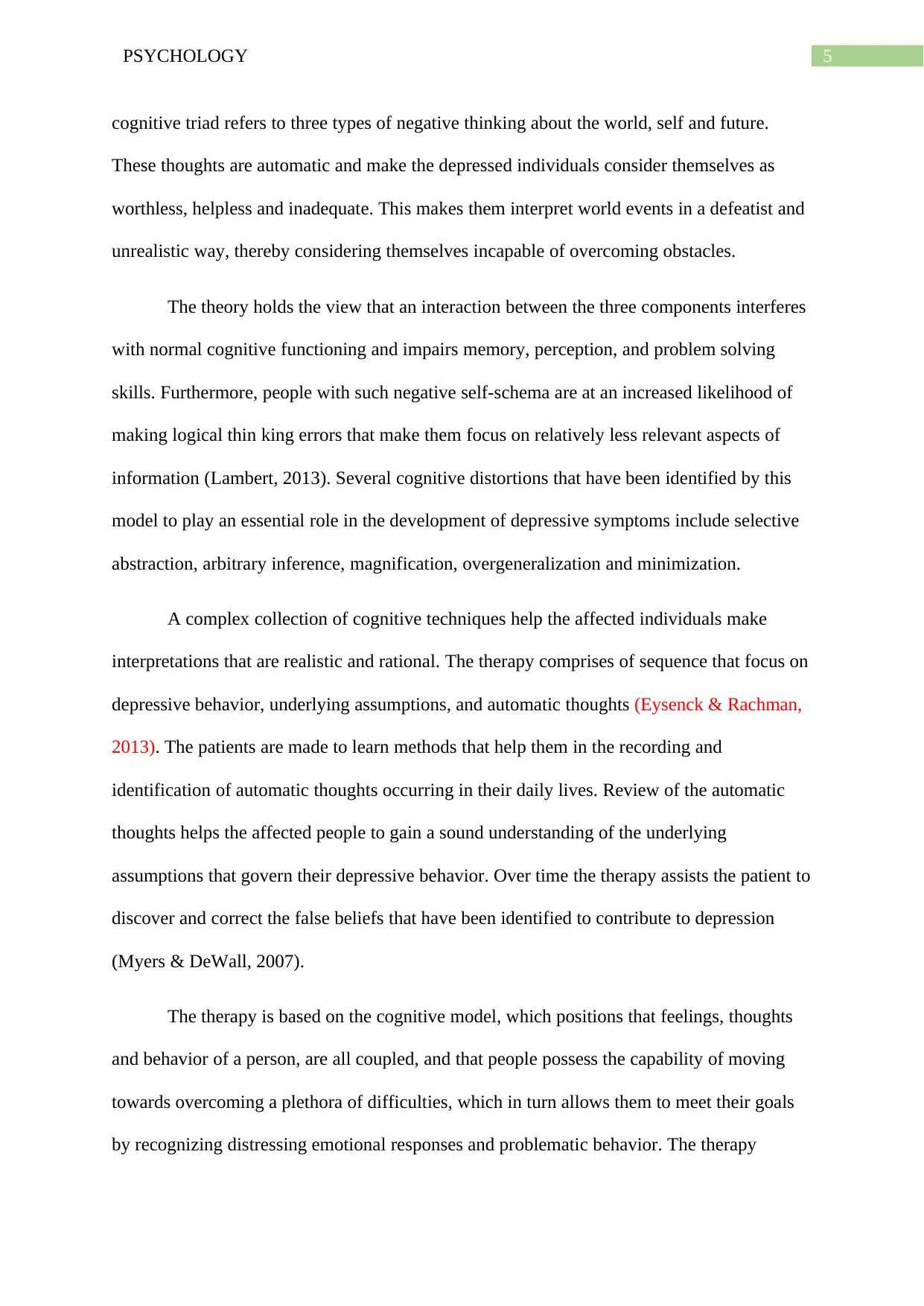
5PSYCHOLOGY
cognitive triad refers to three types of negative thinking about the world, self and future.
These thoughts are automatic and make the depressed individuals consider themselves as
worthless, helpless and inadequate. This makes them interpret world events in a defeatist and
unrealistic way, thereby considering themselves incapable of overcoming obstacles.
The theory holds the view that an interaction between the three components interferes
with normal cognitive functioning and impairs memory, perception, and problem solving
skills. Furthermore, people with such negative self-schema are at an increased likelihood of
making logical thin king errors that make them focus on relatively less relevant aspects of
information (Lambert, 2013). Several cognitive distortions that have been identified by this
model to play an essential role in the development of depressive symptoms include selective
abstraction, arbitrary inference, magnification, overgeneralization and minimization.
A complex collection of cognitive techniques help the affected individuals make
interpretations that are realistic and rational. The therapy comprises of sequence that focus on
depressive behavior, underlying assumptions, and automatic thoughts (Eysenck & Rachman,
2013). The patients are made to learn methods that help them in the recording and
identification of automatic thoughts occurring in their daily lives. Review of the automatic
thoughts helps the affected people to gain a sound understanding of the underlying
assumptions that govern their depressive behavior. Over time the therapy assists the patient to
discover and correct the false beliefs that have been identified to contribute to depression
(Myers & DeWall, 2007).
The therapy is based on the cognitive model, which positions that feelings, thoughts
and behavior of a person, are all coupled, and that people possess the capability of moving
towards overcoming a plethora of difficulties, which in turn allows them to meet their goals
by recognizing distressing emotional responses and problematic behavior. The therapy
cognitive triad refers to three types of negative thinking about the world, self and future.
These thoughts are automatic and make the depressed individuals consider themselves as
worthless, helpless and inadequate. This makes them interpret world events in a defeatist and
unrealistic way, thereby considering themselves incapable of overcoming obstacles.
The theory holds the view that an interaction between the three components interferes
with normal cognitive functioning and impairs memory, perception, and problem solving
skills. Furthermore, people with such negative self-schema are at an increased likelihood of
making logical thin king errors that make them focus on relatively less relevant aspects of
information (Lambert, 2013). Several cognitive distortions that have been identified by this
model to play an essential role in the development of depressive symptoms include selective
abstraction, arbitrary inference, magnification, overgeneralization and minimization.
A complex collection of cognitive techniques help the affected individuals make
interpretations that are realistic and rational. The therapy comprises of sequence that focus on
depressive behavior, underlying assumptions, and automatic thoughts (Eysenck & Rachman,
2013). The patients are made to learn methods that help them in the recording and
identification of automatic thoughts occurring in their daily lives. Review of the automatic
thoughts helps the affected people to gain a sound understanding of the underlying
assumptions that govern their depressive behavior. Over time the therapy assists the patient to
discover and correct the false beliefs that have been identified to contribute to depression
(Myers & DeWall, 2007).
The therapy is based on the cognitive model, which positions that feelings, thoughts
and behavior of a person, are all coupled, and that people possess the capability of moving
towards overcoming a plethora of difficulties, which in turn allows them to meet their goals
by recognizing distressing emotional responses and problematic behavior. The therapy
⊘ This is a preview!⊘
Do you want full access?
Subscribe today to unlock all pages.

Trusted by 1+ million students worldwide
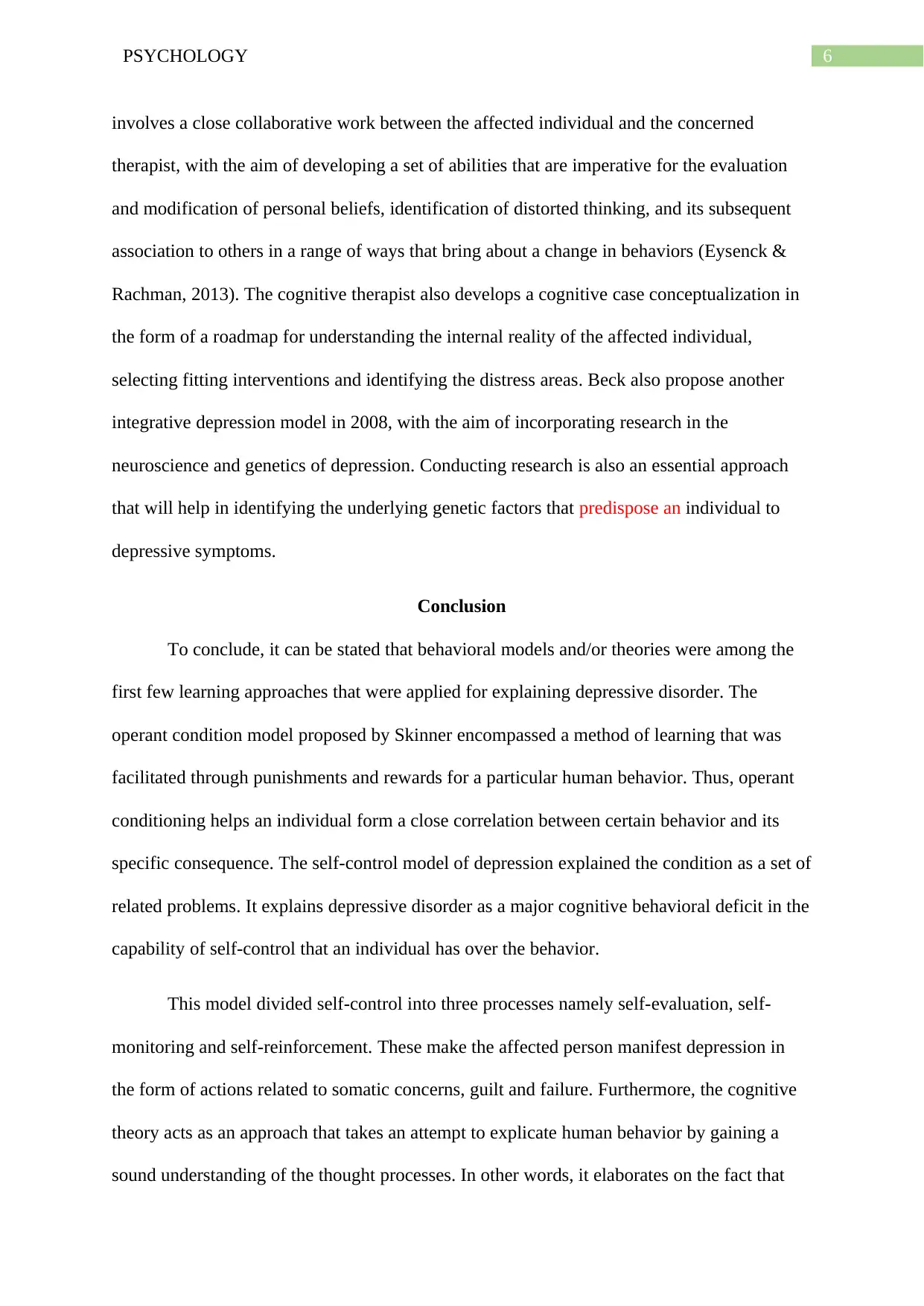
6PSYCHOLOGY
involves a close collaborative work between the affected individual and the concerned
therapist, with the aim of developing a set of abilities that are imperative for the evaluation
and modification of personal beliefs, identification of distorted thinking, and its subsequent
association to others in a range of ways that bring about a change in behaviors (Eysenck &
Rachman, 2013). The cognitive therapist also develops a cognitive case conceptualization in
the form of a roadmap for understanding the internal reality of the affected individual,
selecting fitting interventions and identifying the distress areas. Beck also propose another
integrative depression model in 2008, with the aim of incorporating research in the
neuroscience and genetics of depression. Conducting research is also an essential approach
that will help in identifying the underlying genetic factors that predispose an individual to
depressive symptoms.
Conclusion
To conclude, it can be stated that behavioral models and/or theories were among the
first few learning approaches that were applied for explaining depressive disorder. The
operant condition model proposed by Skinner encompassed a method of learning that was
facilitated through punishments and rewards for a particular human behavior. Thus, operant
conditioning helps an individual form a close correlation between certain behavior and its
specific consequence. The self-control model of depression explained the condition as a set of
related problems. It explains depressive disorder as a major cognitive behavioral deficit in the
capability of self-control that an individual has over the behavior.
This model divided self-control into three processes namely self-evaluation, self-
monitoring and self-reinforcement. These make the affected person manifest depression in
the form of actions related to somatic concerns, guilt and failure. Furthermore, the cognitive
theory acts as an approach that takes an attempt to explicate human behavior by gaining a
sound understanding of the thought processes. In other words, it elaborates on the fact that
involves a close collaborative work between the affected individual and the concerned
therapist, with the aim of developing a set of abilities that are imperative for the evaluation
and modification of personal beliefs, identification of distorted thinking, and its subsequent
association to others in a range of ways that bring about a change in behaviors (Eysenck &
Rachman, 2013). The cognitive therapist also develops a cognitive case conceptualization in
the form of a roadmap for understanding the internal reality of the affected individual,
selecting fitting interventions and identifying the distress areas. Beck also propose another
integrative depression model in 2008, with the aim of incorporating research in the
neuroscience and genetics of depression. Conducting research is also an essential approach
that will help in identifying the underlying genetic factors that predispose an individual to
depressive symptoms.
Conclusion
To conclude, it can be stated that behavioral models and/or theories were among the
first few learning approaches that were applied for explaining depressive disorder. The
operant condition model proposed by Skinner encompassed a method of learning that was
facilitated through punishments and rewards for a particular human behavior. Thus, operant
conditioning helps an individual form a close correlation between certain behavior and its
specific consequence. The self-control model of depression explained the condition as a set of
related problems. It explains depressive disorder as a major cognitive behavioral deficit in the
capability of self-control that an individual has over the behavior.
This model divided self-control into three processes namely self-evaluation, self-
monitoring and self-reinforcement. These make the affected person manifest depression in
the form of actions related to somatic concerns, guilt and failure. Furthermore, the cognitive
theory acts as an approach that takes an attempt to explicate human behavior by gaining a
sound understanding of the thought processes. In other words, it elaborates on the fact that
Paraphrase This Document
Need a fresh take? Get an instant paraphrase of this document with our AI Paraphraser
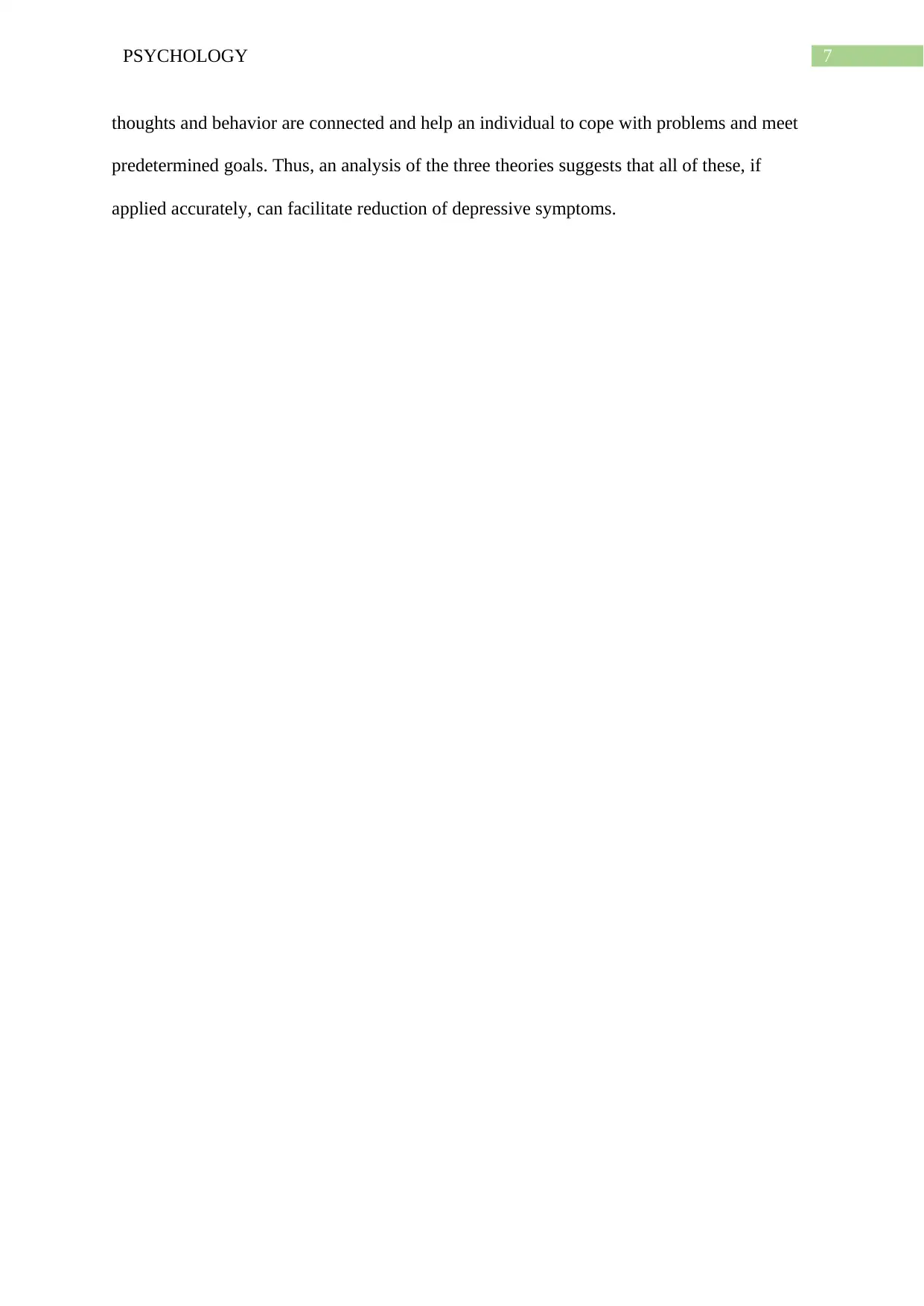
7PSYCHOLOGY
thoughts and behavior are connected and help an individual to cope with problems and meet
predetermined goals. Thus, an analysis of the three theories suggests that all of these, if
applied accurately, can facilitate reduction of depressive symptoms.
thoughts and behavior are connected and help an individual to cope with problems and meet
predetermined goals. Thus, an analysis of the three theories suggests that all of these, if
applied accurately, can facilitate reduction of depressive symptoms.
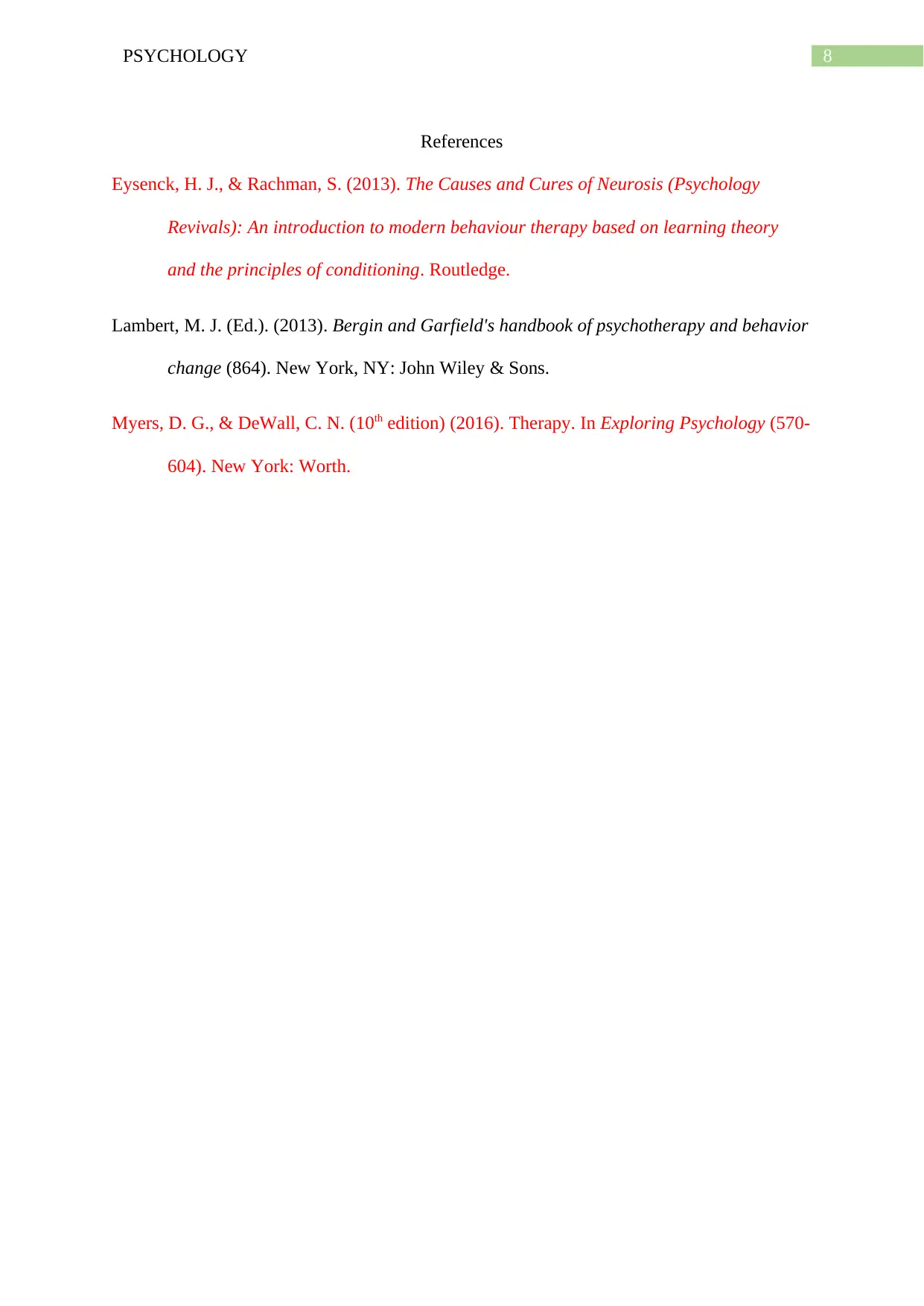
8PSYCHOLOGY
References
Eysenck, H. J., & Rachman, S. (2013). The Causes and Cures of Neurosis (Psychology
Revivals): An introduction to modern behaviour therapy based on learning theory
and the principles of conditioning. Routledge.
Lambert, M. J. (Ed.). (2013). Bergin and Garfield's handbook of psychotherapy and behavior
change (864). New York, NY: John Wiley & Sons.
Myers, D. G., & DeWall, C. N. (10th edition) (2016). Therapy. In Exploring Psychology (570-
604). New York: Worth.
References
Eysenck, H. J., & Rachman, S. (2013). The Causes and Cures of Neurosis (Psychology
Revivals): An introduction to modern behaviour therapy based on learning theory
and the principles of conditioning. Routledge.
Lambert, M. J. (Ed.). (2013). Bergin and Garfield's handbook of psychotherapy and behavior
change (864). New York, NY: John Wiley & Sons.
Myers, D. G., & DeWall, C. N. (10th edition) (2016). Therapy. In Exploring Psychology (570-
604). New York: Worth.
⊘ This is a preview!⊘
Do you want full access?
Subscribe today to unlock all pages.

Trusted by 1+ million students worldwide
1 out of 9
Related Documents
Your All-in-One AI-Powered Toolkit for Academic Success.
+13062052269
info@desklib.com
Available 24*7 on WhatsApp / Email
![[object Object]](/_next/static/media/star-bottom.7253800d.svg)
Unlock your academic potential
Copyright © 2020–2025 A2Z Services. All Rights Reserved. Developed and managed by ZUCOL.




